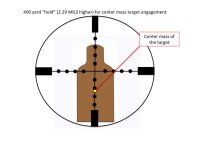LONG RANGE MARKSMANSHIP - PART 3:
READJUSTING THE POINT OF AIM AND POINT OF IMPACT TO 500 YARDS
READJUSTING THE POINT OF AIM AND POINT OF IMPACT TO 500 YARDS
My call sign is Krieger. I am a former Special Forces Soldier (7th Special Forces Group, Ft. Bragg, NC), and security contractor.
SERIES
This is Part 3 of a series titled: Long Range Precision Marksmanship.
Some of the information contained in this post refers to Part 1 and or Part 2 of this series. In order to reference parts 1 and 2 you may find them here:
-https://www.snipershide.com/shooting/threads/krieger_tactics-long-range-marksmanship-part-1.7106280/
-https://www.snipershide.com/shooting/threads/krieger_tactics-long-range-precision-marksmanship-part-2-introduction-to-holding.7106361/
RELEVANCE OF THE MIL DOT RETICLE AND THUS THIS SERIES
The MIL dot reticle system can be used for various actions, to include estimating range to a target and holding (adjusting your point of aim off of the desired impact point of a target) in order to compensate for the external ballistic effect of the wind, etc., on a fired round while it is in flight.
If you are a tactical, long range precision marksman or hunter, the ability to effectively and rapidly engage targets at multiple distances could prove to be critical in your ability to defend yourself or others, win a competition, provide food for your family or others.
---------------------------------
ADJUSTING FOR ENVIRONMENTAL FACTORS
While a fired round is in flight, winds, range and other factors can and do affect the round's path. In order to compensate for this affect on the round's path, a marksman may calculate the deviation upon the fired round caused by the environmental factors and then "dial on" the adjustments utilizing the windage and elevation knobs.
A marksman may also calculate how much he or she may need to hold (aim) off of the desired point of impact in order to allow the round to be brought back onto the target. Aiming off or "holding" as it is know is generally accomplished by applying the appropriate number of MILs in the scope's reticle in order to allow the bullet to fall and or be blown back onto the target.
HOLDING BASED ON A 100 YARD ZERO
For these calculations I will be using example data. To note, your data may (will probably) be a little bit different than that provided. The point here is to understand the process of holding in order to engage targets at range, given a 100 yard zero.
EXAMPLE YARDLINE HOLD IN MILS
YARDS / HOLD IN MILS
100 / --
200 / 0.5
300 / 1.5
400 / 2.5
500 / 3.5
600 / 4.7
700 / 6.1
800 / 7.7
900 / 9.4
1000 / 10.4
APPLICATION
The application of this data would be thus: The rifle is zero’d at 100 yards. A target (as so deemed) presents itself at 400 yards. There are no winds to be calculated. The “hold” in MILs to engage a 400 yard target (with a 100 yard zero) is 2.5 MILs.
In order to engage a center mass or point of desired impact hit, the marksman would then “hold” (raise) the center cross-hair 2.5 MILs above the desired point of impact
NOT ENOUGH MILS AVAILABLE
Since there are only 5 measurable MILs from the center line to the thick black bar at either end of the cross-hairs of the reticle this process can be utilized to engage a target that is 600 yards away or less as any target farther away than 600 yards requires a hold of more than 5 MILs.
ADJUST FOR THIS SHORTCOMING
In order to compensate for this shortcoming:
1. READJUST the dialed on range to 500 yards. 500 yards then becomes the Point of Aim / Point of Impact.
2. RECALCULATE the holds in MILs from:
A. 500 yards to 100 yards
B. 500 yards to 1000 yards
Example holds with a DIALED ON RANGE of 500 yards.
YARDS / MIL HOLDS
100 / 3.4 UNDER
200 / 2.7 UNDER
300 / 1.9 UNDER
400 / 1.0 UNDER
500 / POA/POI
600 / 1.1 OVER
700 / 2.3 OVER
800 / 3.7 OVER
900 / 5.2 OVER
1000 / 6.8 OVER
EXAMPLE
The marksman sees two targets.
The first target appears at a range of 200 yards away.
The second target appears at 800 yards away.
The marksman desires to engage BOTH targets.
Using the data above the marksman, in order to engage the target at 200 yards would “hold” 2.7 MILs UNDER the desired point of impact and engage the target:
Then, in order to engage the target at 800 yards away, the marksman would hold at 3.7 MILs OVER the desired point of impact on the 2nd target:
TAKE-AWAY
The ability to rapidly engage targets from 100 yards out to 1000 yards could be important in your long range precision marksmanship ability. While “dialing on” the elevation (range) change is a possible solution, this process also introduces issues such as loss of battlefield situational awareness, etc. These issues are easily remedied by simply readjusting the POA/POI to 500 yards and then “holding” the requisite number of MILs.
Would I advocate this process everyone? No, I would not. I would advocate that if you need to fire one or multiple rounds and you have a limited time to engage an exposed target or targets, it might be a technique that could prove favorable
FUTURE POST
You may find yourself in a situation where you want to engage a target using a hold, but the available MILs in your scope do not allow allow for this. I'll show you a method that you might be able to emloy in order to address this situation.
-Krieger
#greenberet, #longrangemarksmanship #remington #longrangeshooting #M24sws #M118 #sniper #precisionmarksmanship #precisionshooting #DDM #specialforces #specialoperations
Attachments
Last edited:




